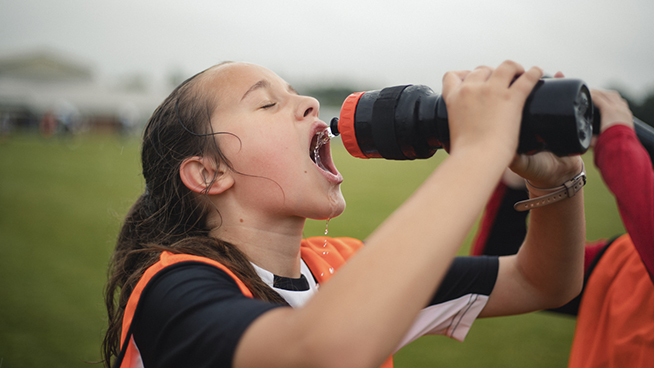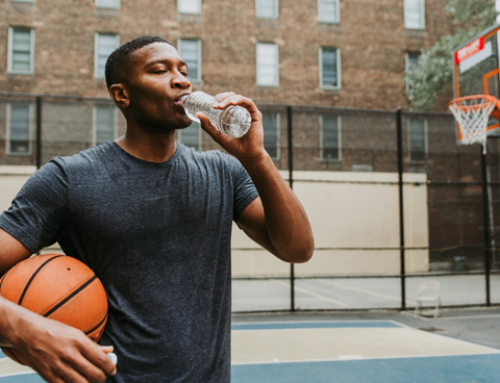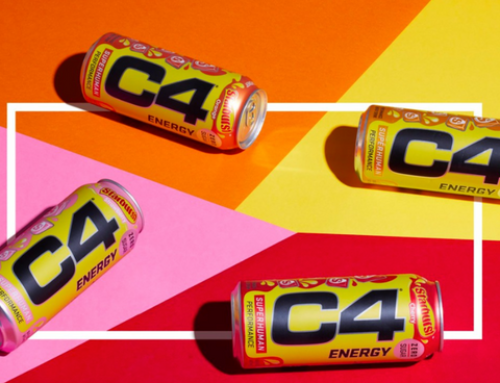BPA: Health Hazard In Your Water Bottle?
Regularly taking swigs from the team’s water cooler or water bottle? It may not be as beneficial to your health as you think.
In the heat of summer practices, hydration is a key driver of successful performance. (See Bob Seebohar on Summer Hydration.) But if you’re drinking out of a BPA-contaminated bottle, you may potentially be setting yourself up for costly future health risks.
What is BPA?
BPA (bisphenol A) is a chemical commonly found in both disposable and washable water bottles, electronic equipment, eyeglass lenses and the linings of metal food cans. It can even be found in mouth guards and other dental products.
Why is BPA dangerous?
Scientists believe BPA is potentially “endocrine disrupting.” This is a medical term that describes the process by which synthetic chemicals mimic estrogen behavior or impact hormonal activity [1].
It’s widely believed that when BPA enters the human body, it interferes with the natural function of estrogen, causing conflicting hormonal messages to be sent and disrupting estrogen’s otherwise normal signals. (To be clear, males do have estrogen—along with testosterone—to ensure healthy functioning.)
Products that contain BPA are not harmful to touch. The danger is when BPA leaches into food or liquids and is consumed. Ever leave your water bottle lying on the ground during a hot practice outside? When BPA is exposed to heat, its endocrine-disrupting behavior is boosted, and anything that comes into contact with the chemical soaks up greater quantities of BPA.
BPA’s Health Effects
There are several potential side effects of BPA on the human body:
- Hormonal changes
- Behavioral issues
- Heart issues
- Cancer
A Safe Approach to BPA
There is some disagreement in the medical community about the hazards of BPA, but it’s generally accepted that it “shows some endocrine ‘effects.'” It is also believed that children are at higher risk for BPA’s side effects. (See this Forbes article for more insight.)
For now, it’s best to play it safe. You always want to be cautious about what you put in your body. Look for BPA-free mouth guards and water bottles. Throw away household products that may contain BPA. This will eliminate the potential hazards of the chemical getting into your body when you eat and drink. (Here is a list of BPA health tips from the American Medical Association.)
This summer, hydrate without worrying about BPA affecting your performance or your future.
Source
[1] Patisaul, H. B., & Adewale, H. B. (2009). “Long-term effects of environmental endocrine disruptors on reproductive physiology and behavior.” Frontiers in Behavioral Neuroscience, 3.RECOMMENDED FOR YOU
MOST POPULAR
BPA: Health Hazard In Your Water Bottle?
Regularly taking swigs from the team’s water cooler or water bottle? It may not be as beneficial to your health as you think.
In the heat of summer practices, hydration is a key driver of successful performance. (See Bob Seebohar on Summer Hydration.) But if you’re drinking out of a BPA-contaminated bottle, you may potentially be setting yourself up for costly future health risks.
What is BPA?
BPA (bisphenol A) is a chemical commonly found in both disposable and washable water bottles, electronic equipment, eyeglass lenses and the linings of metal food cans. It can even be found in mouth guards and other dental products.
Why is BPA dangerous?
Scientists believe BPA is potentially “endocrine disrupting.” This is a medical term that describes the process by which synthetic chemicals mimic estrogen behavior or impact hormonal activity [1].
It’s widely believed that when BPA enters the human body, it interferes with the natural function of estrogen, causing conflicting hormonal messages to be sent and disrupting estrogen’s otherwise normal signals. (To be clear, males do have estrogen—along with testosterone—to ensure healthy functioning.)
Products that contain BPA are not harmful to touch. The danger is when BPA leaches into food or liquids and is consumed. Ever leave your water bottle lying on the ground during a hot practice outside? When BPA is exposed to heat, its endocrine-disrupting behavior is boosted, and anything that comes into contact with the chemical soaks up greater quantities of BPA.
BPA’s Health Effects
There are several potential side effects of BPA on the human body:
- Hormonal changes
- Behavioral issues
- Heart issues
- Cancer
A Safe Approach to BPA
There is some disagreement in the medical community about the hazards of BPA, but it’s generally accepted that it “shows some endocrine ‘effects.'” It is also believed that children are at higher risk for BPA’s side effects. (See this Forbes article for more insight.)
For now, it’s best to play it safe. You always want to be cautious about what you put in your body. Look for BPA-free mouth guards and water bottles. Throw away household products that may contain BPA. This will eliminate the potential hazards of the chemical getting into your body when you eat and drink. (Here is a list of BPA health tips from the American Medical Association.)
This summer, hydrate without worrying about BPA affecting your performance or your future.












